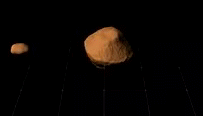Squannite (moon)
| (66391) Moshup I Squannitol | |
|---|---|

|
|
| Moshup and Squannit (left) | |
| Provisional or systematic name | S / 2001 (66391) 1 |
| Central body | (66391) Moshup |
| Properties of the orbit | |
| Major semi-axis | 2.548 ± 0.015 km |
| Periapsis | 2.547 km |
| Apoapsis | 2.549 km |
| eccentricity | 0.0004 ± 0.0019 |
| Orbit inclination | 156.1 ° ± 2.0 ° |
| Orbital time | 0.7259 ± 0.0015 d |
| Mean orbital velocity | 0.0002391 km / s |
| Physical Properties | |
| Medium diameter | 0.451 ± 0.027 km |
| Dimensions | 1:35 ± 0:24 · 10 11 kg |
| surface | 0.639 km 2 |
| Medium density | 2.8 g / cm 3 |
| Sidereal rotation | 0.7259 ± 0.0015 |
| Acceleration of gravity on the surface | ~ 0 m / s 2 |
| Escape speed | ~ 0 m / s |
| discovery | |
| Explorer |
Petr Pravec |
| Date of discovery | May 21, 2001 |
| Remarks | Double system closest to the sun |
Squannite (officially (66391) Moshup I Squannite , provisional designation S / 2001 (66391) 1 , formerly sometimes also known as 1999 KW 4 Beta ) is a moon of the main belt - asteroid (66391) Moshup . Its estimated diameter is around 450 meters. The moon and its parent asteroid are the closest binary system to the sun .
Discovery and naming
The discovery of squannite was suggested by a Czech team of astronomers under Petr Pravec and Lenka Kotková (-Šarounová) from the Ondřejov observatory through photometric observations on June 19, 2000, which was later suggested by radar observations from the Arecibo observatory by a team under Steven J. Ostro bis was confirmed for official discovery on May 21, 2001.
The discovery was announced by the International Astronomical Union (IAU) two days later on May 23, 2001, and the moon was given the temporary designation S / 2001 (66391) 1 . On August 27, 2019, the Minor Planet Center announced that it had received the name squannite , analogous to the mother asteroid , after the wife of Moshup, who was a medicine woman of the Makiawisug (little people) people.
Track properties
Squannite orbits the common barycentre on a retrograde , almost circular orbit at an average distance of 2.548 km from the planetoid, which corresponds to 3.9 Moshup radii and 11.3 squannite radii. The moon needs 17 hours 25.2 minutes for one orbit, which corresponds to around 259 orbits in a moshup year. The orbit eccentricity is 0.0004, the orbit is inclined 156.1 ° in relation to the equator of Moshup . With this, the moon moves far within Moshup's Hill sphere of 22 km.
In this binary system, a month is 6.3 moshup days .
Physical Properties
Size and structure
The observations made so far indicate an irregularly shaped, elongated body; the most precise determination of the diameter ( geometric mean ) is 451 ± 27 meters. With regard to the exact dimensions, the most precise value is 0.571 × 0.463 × 0.349 m. The discovery of the moon had no significant influence on the determination of the size of the mother asteroid, which is currently estimated to be around 1.3 km in size. Squannite thus has about a third of the diameter of Moshup, which means that its density of 2.8 g / cm 3 is assumed to be significantly higher than that of Moshup, which is probably a so-called rubble pile . Accordingly, squannite should be more compact than the mother asteroid. It is believed that both bodies were created by a collision of a protoasteroid with another asteroid. The differences in composition could be due to the phenomenon of libration .
Based on the mean diameter of 451 meters, the surface area is around 0.64 km 2 . Squannite is 2.5 magnitudes fainter than moshup.
rotation
Squannite, bound, rotates once around its axis in 17 hours and 25.2 minutes, with the long axis aligned with Moshup. It follows that the asteroid in a Moshup-year, approximately 259 own twists performs.
See also
Web links
Individual evidence
- ↑ v ≈ π * a / period (1 + sqrt (1-e²))
- ↑ P. Pravec et al. a .: Photometric survey of binary near-Earth asteroids . In: Icarus . 181, No. 1, March 2006, pp. 63-93. bibcode : 2006Icar..181 ... 63P . doi : 10.1016 / j.icarus.2005.10.014 .
- ^ Wm. R. Johnston: (66391) 1999 KW4 . Johnston's Archives. September 20, 2014. Retrieved October 15, 2019.

